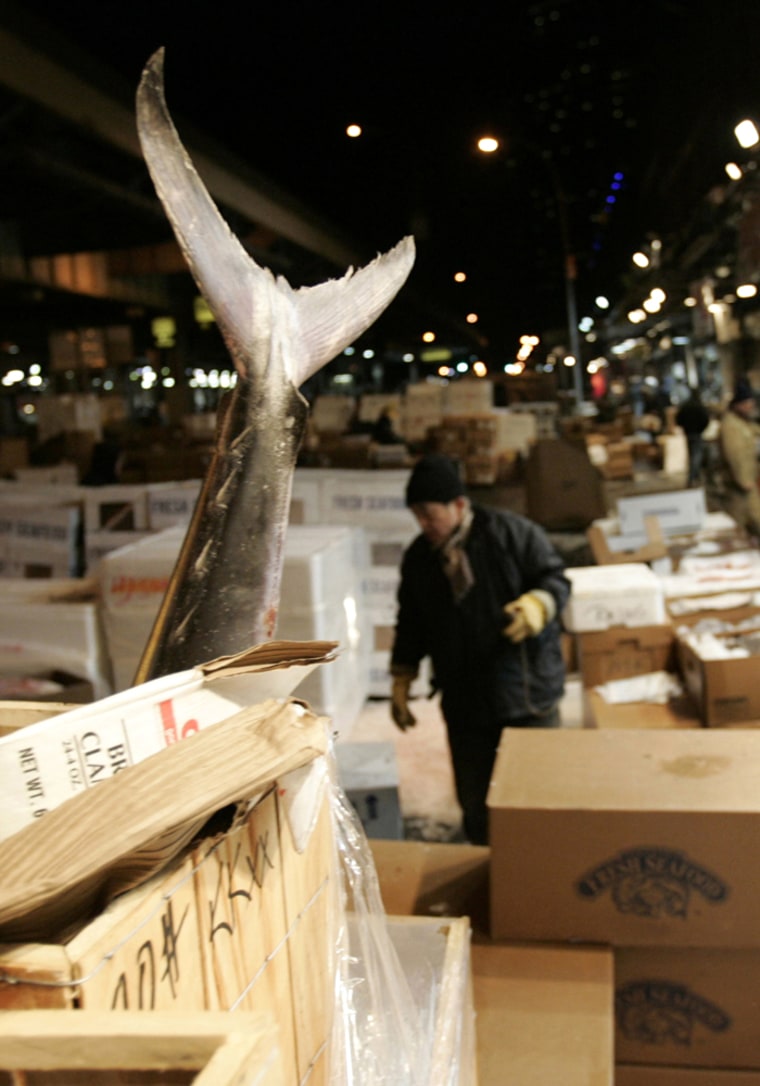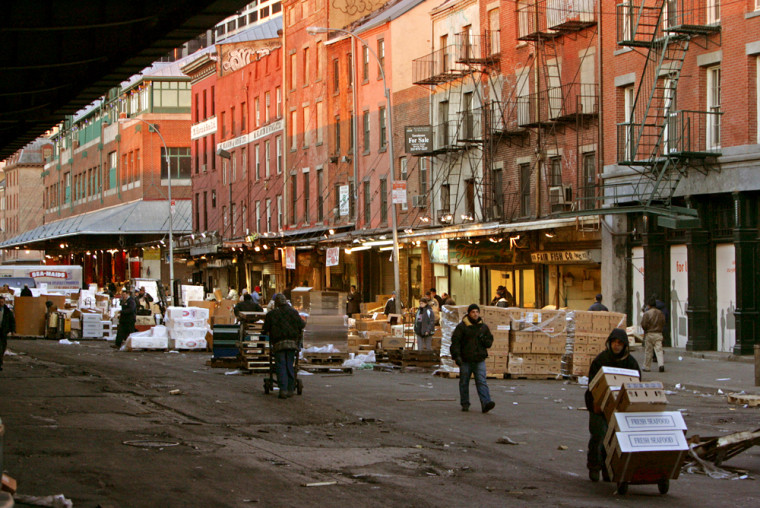In a pristine Bronx building more than four football fields long, the smell of the future floats in: a whiff of fish that hits the nose when Frank Minio enters.
The fish vendor has just arrived at the empty new edifice from his overnight work at Manhattan’s Fulton Fish Market, which each year sells about $1 billion worth of seafood from around the globe — one of the largest markets of its kind, along with those in Tokyo, London and Sydney, Australia.
In July, after more than 180 years, the sea of open stalls by the Brooklyn Bridge will move to its new South Bronx home. Under an American flag flying from its 50-foot ceiling, the market will offer everything from Maryland crab, tuna from Trinidad and red snapper from South Africa to Long Island porgies and Canadian lobster, still wiggling.
“It’ll be 400,000 square feet of fresh seafood — the largest fish market in the Western Hemisphere,” says George Maroulis, manager of the South Bronx venue.
Last breaths of dying tradition
For the men at Fulton, it’s been a long, hard goodbye to the old market, which first opened in the early 1800s by the East River during the city’s seafaring heyday. The next weeks will see the last breaths of a dying tradition: the open-air market coming alive with boisterous bartering starting after midnight and winding down as the dawn sun lights the red brick storefronts and cobblestone streets under Wall Street’s financial towers.
As raw as the glistening fish that blanket the stands above the pavement, spilling onto the street in crates, New York’s “blab of the pave” — as poet Walt Whitman called it — vibrates with a gritty virility.
The romance is almost over.
“The move will be like falling asleep in the 19th century and waking up in the 21st century,” says Maroulis.
An inevitable move
The vendors are to pack up after business ends at daybreak on a Friday, reopening Sunday at midnight in their new digs in the Hunts Point neighborhood about a 10-mile drive away.
The fishmongers are still in the process of “customizing” their individual spaces, said Janel Patterson of the New York City Economic Development Corp., which oversees the market.
Barring any unforeseen hurdles, July 18 is the target date for opening the $80-million-plus, state-of-the-art facility, Maroulis said.
The move was inevitable.
For one thing, the U.S. Food and Drug Administration now requires that all fish must be refrigerated indoors.
Modernizing means a well-lighted, indoor space climate-controlled at 41 degrees to keep seafood fresh, rather than sitting outdoors exposed to temperatures ranging from single digits in winter to sweltering summer heat.
Water-draining trenches line the concrete central hall, with both hot and cold water running into the stainless-steel sinks. Stairs lead up to the offices of each company, where amenities like showers sit behind glass facades marked with names of businesses stretching as far as the eye can see. Underneath each company space are their refrigeration boxes.
Outside in the mammoth parking lot, the monster trucks delivering seafood packed on ice will drive straight up to docking bays, rather than squeezing through the cramped, zigzag streets of lower Manhattan. Business hours will be flexible compared to the old market, which is always under pressure to clear out before the morning rush hour descends on Manhattan’s business district.
A colorful fixture
Still, some old-timers say they’ll miss the seasons and the fresh-air freedom.
“The new place looks like an airport hangar, or a jail. It has no windows where we’ll work — it’ll be like an office job,” says Ziggy Galarza, 44, who has spent more than half his life selling fish outdoors at Fulton, where vendors gross an average of $1,500 a week each.

The old market has been one of New York’s most colorful fixtures since it opened on Feb. 5, 1822. Fulton offered what the Pittsfield (Mass.) Sun called “the handsomest exhibition of Beef, Mutton, Pork ever presented to the public.”
The city chose the site because the nearby Fulton Ferry could reach Long Island farmers who provided New York with vegetables. Within the next decade, fish merchants had their own space, and it’s stayed that way, though no fish have arrived by boat in about three decades. Instead, they’re flown in through Kennedy International Airport or trucked in from as far away as Florida and Canada.
After the move, the city-owned waterfront will go upscale, likely with luxury condos, restaurants and designer stores joining the gentrified South Street Seaport that also offers attractions like historic tall ships.
But Fulton’s basic character won’t change much.
Testosterone central
No doubt, amid the fish flesh, gaff hooks and ice, this is testosterone central — an enclave of hundreds of men whose bartering skills reach fever pitch in the dead of night as restaurateurs and grocery store owners from all over the East Coast purchase their seafood for the week.
At around 3 a.m., some men head for a break at the 1873 Cafe de Paris, a bar and restaurant whose customers over the years have included everyone from Thomas Edison and Annie Oakley to mobster Albert Anastasia.
Back outdoors, the fishmongers’ expletive-rich shouts fill the damp night air. Tiny forklifts dubbed “hi-los” zip around with demolition-derby energy that accelerates toward dawn, sending pedestrians scuttling out of the way.
The seagulls that now sweep over Brooklyn Bridge’s stone arches will be replaced by the cry of gulls swooping over the prison barge moored next to the new fish market, which also looks out over the East River at Rikers Island, the city’s largest jail.
'A whole new world'
On a sunny morning, the only sound echoing through the gleaming new space are Minio’s footsteps, driven by a fresh economic purpose.
“We’re excited. I love where this building could go. It’s a whole new world like this city’s never seen — a center of anything connected to seafood,” says Minio, a 56-year-old former actor and college literature teacher who has emerged as a leader among more than 40 Fulton merchants.
He grows poetic when describing the old market. “As you approach in the evening, you’re enraptured seeing the light, getting bigger and bigger. And all of a sudden, there’s all this life and movement while the city sleeps.”
The grandson of a Sicilian immigrant, Minio is president of Smitty’s Fillet House, a family business that sells about 35,000 pounds of fish per night.
The New Fulton Fish Market at Hunts Point — as the sign at the entrance reads — is just a few hundred yards from the city’s 329-acre wholesale produce market and a lineup of businesses that recycle trash and banged-up cars for parts.
'A true market'
The road that leads there, Bruckner Boulevard, gained fame in Thomas Wolfe’s novel “The Bonfire of the Vanities,” which begins with a wealthy Manhattanite whose life spins out of control after a car accident in the crime-and-grime-filled Bronx of the 1980s.
The market will bring the no-man’s-land of desolate lots ringed with razor wire full circle — back to its tradition as a waterfront community of crabbers and fishermen.
“It’ll be a true market, like the kind you read about in economics books. There are buyers and sellers, looking, comparing. You can touch the fish, feel it, look at the eyes for freshness,” says Maroulis.
In Manhattan, the fishmongers will leave behind the odor of fish so ingrained into the pavement and brick below the Franklin D. Roosevelt Drive that some motorists roll up their windows as they drive by.
At the new facility, with everything hosed down shiny every day, says Minio, “it won’t smell. Fresh fish don’t smell. It’s just blood and water.”
And that smells like a billion dollars a year.
